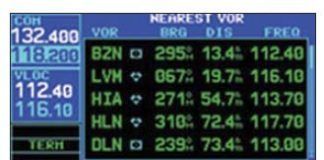Maybe we’re too busy focusing on the forest and the trees that the dirt making up the foundation of the arbors is ignored. Or perhaps it’s the elephant in the room no one discusses. Instructors don’t teach it because they don’t understand the opaque system themselves—can’t teach something you don’t know. Whatever the cause, many pilots have a poor understanding of how aeronautical information travels through the system and how charts are updated.
Why fend off paper cuts every few weeks or get the notice to update your data every time you fire up your electronic flight bag? Why are Jepps updated every two weeks while government charts update at four weeks? What about databases? Why do some charts have effective dates and other don’t?
Understanding how aeronautical changes travel throughout the system is essential for instrument pilots—especially accomplished ones. Without an understanding of this process, one will never be able to achieve a high level of understanding about how charts, databases and NOTAMs work. And it all starts with an odd little acronym, AIRAC.
AIRAC
AIRAC stands for Aeronautical Information Regulation And Control. It’s described by Jepp as “an internationally agreed upon series of common dates for States to publish aeronautical information.” AIRAC originates in ICAO Annex 15, which covers Aeronautical Information Services, and dates back to 1964. The idea is simple. Participating counties issue changes to aeronautical information on the same 28-day cycle. Imagine the mess an area like Europe would be if each country decided to update information on different schedules. In fact, in 1999 at least 20 safety incidents in Europe were attributed to AIRAC non-adherence.
Aeronautical Information Services (AIS) may be a new concept for some, although it’s the current name of the FAA’s old Aeronav (or NACO for those really behind the times). The FAA changed the name to match the international standard of AIS. AIS departments collect, validate, store, maintain, and disseminate aeronautical data. Airport operators, procedure designers, airspace planners and others feed information to AIS that then pushes it into charting and publications.
Annex 15 includes a list of what should be covered by AIRAC. Some of the items are holding and approach procedures, arrival and departure procedures, noise abatement procedures, any other pertinent ATS procedures, transition levels, transition altitudes, minimum sector altitudes, runways, stopways, ground operating procedures (including low visibility procedures), approach and runway lighting and aerodrome operating minima (if published by a State).
Fundamentally, AIRAC is a quality control process to ensure coordination of changes within the global airspace system. It ensures everyone is playing from the same sheet of music when it comes to aviation information.
Dating AIRAC
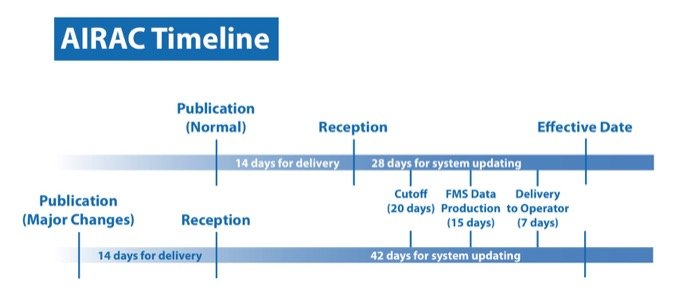
A process is simply a series of steps. AIRAC controls the process by aligning the steps with calendar dates. You can think of AIRAC as a fixed Gantt chart with dates data must pass through. These dates, in chronological order, are cut-off, publication, reception, freeze, issue and effective.
The cut-off date is the latest the Aeronautical Information Service (AIS) provider can accept changes for a particular cycle. Information is then published by AIS and sent to chart and navigation database companies. This publication date should be at least 42 days before the effective date. Note that this isn’t the date Jeppesen or FAA AIS publishes their charts and sends them to you. It’s the date by which AIS must send the data to Jepp or the FAA (or others).
The chart creators are supposed to receive the information sent by AIS by the reception date, which is 28 days prior to the effective date. FedEx can deliver a parcel anywhere in the world in far less time and electronic transmittal of information takes seconds, but tracking latency is part of the AIRAC quality control program.
Each chart provider has their own internal freeze date; any changes received after that date won’t be included in an update. It takes time to incorporate changes and go through their internal quality control processes.
The issue date is published on the top of Jepp approach charts, located to the left of the chart number. FAA AIS does not print the issuance date.
Here’s the important one: the effective or AIRAC date. The AIRAC date occurs every 28 days on a Thursday. Each country determines the exact time of the switchover to coincide with low air traffic volume. In the U.S. it is 0900 Zulu or 1200 a.m. to 0400 a.m. local depending on time of year and zone.
Jepp will print the effective date to the right of the chart number in inverted color (white script on black background). FAA AIS prints the effective dates (they print the start and end dates of the AIRAC cycle) on the side of the electronic chart or the front of the booklet of printed charts.
FAA AIS makes an important statement about effective dates on its websites:
Published instrument procedures and routes are incorporated by reference into 14 CFR Part 95 and 14 CFR Part 97, are “law.” They are “effective” only during the AIRAC cycle dates specified on the enroute chart/TPP covers or on the side of the chart when printed from the digital-TPP. If you are using a published procedure before or after the dates specified on the chart under IFR, you are technically in violation of the law.
It’s interesting this seemingly definitive statement puts effective in quotes. Obviously using an ILS before it is commissioned or after it is decommissioned isn’t a great idea.
The AIRAC date, ideally, is also the time when scheduled changes occur. For example, if a new frequency can be switched on, that should occur on the AIRAC date.
How Charts Change
Charts change. Jepp happens to publish charts with an effective date, as well as publishing charts without an effective date. As I type, it’s March 10th, a mid-cycle issuance date for Jepp. The next AIRAC date is March 30th and none of the charts issued have an effective date.
Charts without an effective date incorporate updates that don’t change the 14 CFR Part 97 instrument procedure. The change could be an update to charting criteria (how things are depicted) or clarification of wording, but frequently the change is based on a D-NOTAM.
Let’s look at Rochester, NY (KROC), which was updated on Jepp’s March 10th cycle. The following two NOTAMs apply to ROC:
!ROC 01/534 (KROC A1003/17) ROC RWY 22 PAPI COMMISSIONED 1701301710-PERM
!ROC 11/214 (KROC A2949/16) ROC RWY 22 VASI DECOMMISSIONED 1611291429-PERM
The airport updated the visual approach lighting for Runway 22, replacing the VASI with PAPI. The change occurred on January 30 (NOTAM times are read YYMMDD), which was not an AIRAC date. Therefore a D-NOTAM was issued making pilots aware of the change. According to FAA Order 7930.2 governing NOTAMs, a condition expected to last longer than four charting cycles (224 days) is considered permanent. This is denoted by “PERM” instead of the ending date/time grouping.
Jepp updated the KROC charts from VASI to PAPI on the March 10 cycle. Since these changes match the published NOTAMS, the charts can be used as soon as received, or a pilot could delay updating until the next AIRAC cycle date, which is March 30. Either way, the pilot should have the information necessary either on the chart or in the NOTAMs.
With the correct visual lighting system on KROC charts, why is the NOTAM still being published? Permanent NOTAMS stop being published when they have been incorporated into effected documents. For most NOTAMs it takes a 56-day cycle (two AIRAC dates) to be fully integrated.
Charts that have an effective date either have changes that occur on the effective date or are incorporating FDC NOTAMs changing a 97 standard instrument approach procedure. Order 7930.2 states that permanent conditions result in “amended SIAPs and textual ODPs as well as correction information for U.S. Government aeronautical charts.” The order continues, “procedural amendments may be charted from the permanent NOTAM information.”
FDC NOTAMs effecting instrument flight procedures are sent to chart creators in a Transmittal Letter with a set AIRAC date. The February 24 Transmittal Letter contained changes that become effective on the March 30 AIRAC date. For example, a note will be added to the ILS RWY 9 in MIA prohibiting coupled approaches. Although this change matches the published FDC NOTAM, there will still be an effective date since the 97 procedure changed.
Effective Vs. Current
According to the July/August 1997 issue of FAA Aviation News (now titled FAA Safety Briefing), “it is not FAA policy to violate anyone for having outdated charts” and “not all pilots are required to carry a chart.” Only operations governed by 91.503(a), 135.83, and 121.549 are required to carry current charts. (The AIS website affectionately refers to the last two regs as “Air Carrier—Little Airplanes” and “Air Carrier—Big Airplanes”).
That yellowing issue of FAA Aviation News does mention that;
if a pilot is involved in an enforcement investigation, and there is evidence that the use of an out-of-date chart, no chart, or an out-of-date database contributed to the conditions that brought on the enforcement investigation, then that information could be used in any enforcement action taken.
Additionally, the nav database in your G1000 doesn’t enjoy the same flexibility. AC 90-100A expects the database to be current. Plus, it’s just a bad idea to use outdated charts. Charts are there the help us and current charts are an easy way to prevent errors, this is one reason Jepp publishes charts on a two-week cycle.
The Data You Need
How do you ensure you have the information necessary? Simply update charts by the AIRAC date. (The caveat is that you are flying in countries that comply with Annex 15, which is most.) Slacking on chart updates puts the onus on you to carefully check NOTAMs.
There is no guarantee that you have all the information needed if you’re past the AIRAC date without getting a chart update. Once the AIRAC date passes, charts can contain changes that either weren’t published as a NOTAM or those NOTAMs may no longer be published.
For most subscribers, Jepp charts come out on a two-week cycle. The first two-week cycle contains charts with only an issue date since they are based on either published D-NOTAMs or changes such as Jepp cartographic depictions that don’t change the procedure itself.
The second set of charts are issued the Friday before the AIRAC date (six days before the Thursday AIRAC date). Some of these charts may have an effective date of the AIRAC date and should not be used until them.
AIS takes a different path to updating charts. Charts are issued every 56 days (two AIRAC dates), but contain a mid-cycle update at 28 days. Each set, the original and update, are only effective for one AIRAC cycle, which are the dates published on the side of the charts.
Many chart providers contain non-AIRAC information in their manuals. For example, Jeppesen manuals contain state rules and procedures, air traffic control data and entry requirements. Much of this information doesn’t need to be updated on the AIRAC cycle and can result in more frequent updates.
The complex and dynamic information in aviation is constantly changing. AIS collects, validates, stores, maintains, and disseminates this data. New info changes the charts, which are updated following the AIRAC cycle described in ICAO Annex 15. The key to understanding AIRAC is that all databases and charts should be updated by that date.
As instrument pilots, we rely on aeronautical data to keep us safe. We carry it in databases, charts and NOTAMs. Understanding how charts are updated results in a better understanding of the tools many of us use daily. Since, like most of the rest of the world I use digital charts, I just need to figure out what to do with my old chart binders.
Procedure Dates
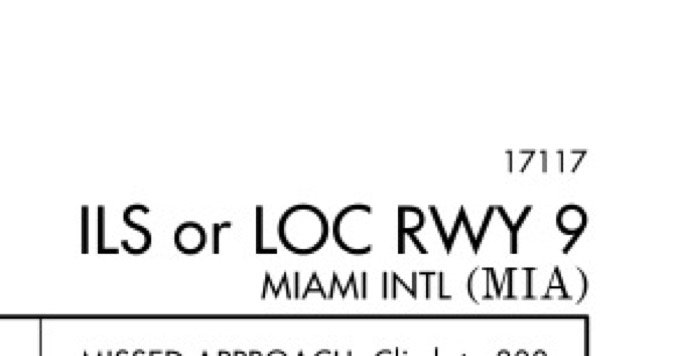
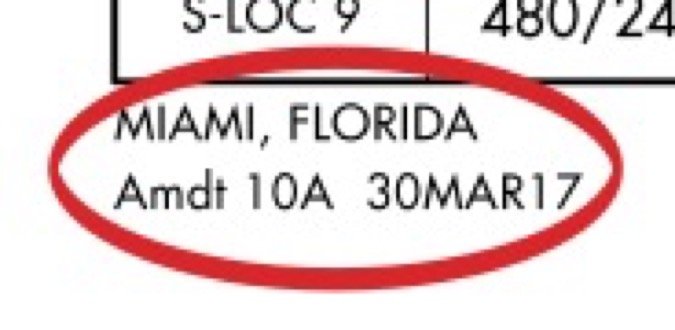
Although FAA AIS doesn’t publish an issue date, the agency does publish a revision date. The revision date is displayed on the top right of the chart as a two digit year followed by three digit day of the year. For example, on the chart for MIA ILS 9, the revision date is 17117, for the 117th day of 2017, or April 27, 2017. How you’re supposed to translate the cryptic 17117 on the chart to actual date of 27APR2017 is beyond me.
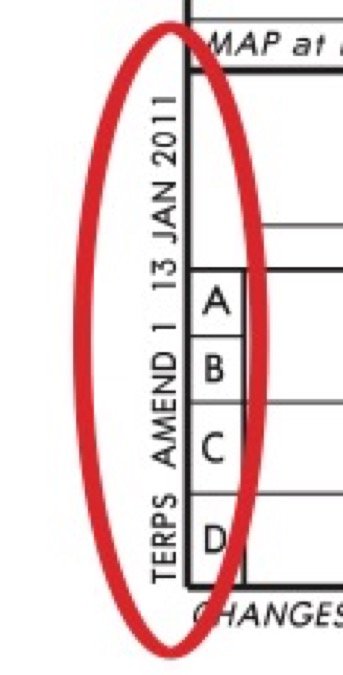
If charts don’t have enough numbers and letters, let’s add another: procedure amendment date. The procedure amendment date tracks 97 changes. Differences between a revision date and procedure amendment date indicate a non-Part 97 change. AIS puts the chart amendment date horizontally at the bottom left of the chart. Jeppesen also puts it on the bottom left, but places it vertically on the left margin. Why is the amendment date important?
If the AIRAC cycle will change during flight, operators and pilots should establish procedures to ensure the accuracy of navigation data, including suitability of navigation facilities used to define the routes and procedures for flight. To facilitate validating database currency, the FAA has developed procedures for publishing the amendment date that instrument approach procedures were last revised. (AIM 1-2-3 Note 4.)
To validate an approach in a database, just make sure the procedure amendment date on the chart is before the database was issued. With a little creativity, this process could be used to validate database information older than a single AIRAC cycle. But who’s actually checking this? Probably not very many of us.
Jordan Miller upped his eyeglass’s prescription to better examine the Lilliputian details on charts. He’s an ATP and CFII.





